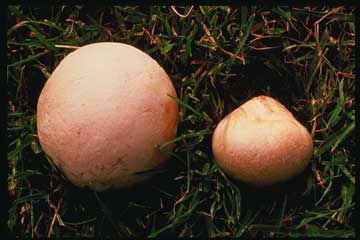
Standard English Name(s):
puffballs (and probably also
puffbowl)
Local English Name(s) (if different from above):
Scientific Name(s): various species of Bovista, Bovistella,
and, Lycoperdon (puffballs); Calvatia gigantea (Batsch
ex Pers.) Lloyd (giant puffball); and Vascellum pratense (Pers.)
Kreisel (puffbowl)
Upriver Halkomelem Name(s): papkw'um
Downriver Halkomelem Name(s): s'utl'qul tu kwasun ('star dung')
Island Halkomelem Name(s):
Description, Habitat,
Ecology, & Distribution:
The puffballs include a range of
fungal species that share the common characteristic of producing spherical
fruiting bodies that contain the tiny reproductive spores. Depending
upon the species, these puffballs either produce apical pores through
which the spores are discharged when pressure is applied, or the walls
of the fruiting bodies disintegrate in an indefinite patter to allow
the spores to escape. Puffbowls are similar to puffballs, but leave
behind a large, bowl-shaped base after disintegrating. Several types
of puffballs and puffbowls occur throughout the Halkomelem territory,
and one or more species were recognized and named by Halkomelem speakers.
Upriver Halkomelem Cultural
Role(s):
Puffballs of many species (reportedly
including C. gigantea and Lycoperdon spp. but possibly
including other species) are said to be notably present at the place
called Popkum. The name " Popkum" is an anglicized version of the Upriver
Halkomelem term for "puffball," papkw'um. These puffballs were eaten.
The powdery spores were rubbed on the navels of infants to prevent bed
wetting. The spores are known to cause harm to the eyes.
Downriver Halkomelem Cultural Role(s):
Island Halkomelem Cultural Role(s):
CAUTION: This species may be harmful. The spores of many fungi, possibly
including those of puffballs and puffbowls, can cause discomfort or
harm if they come into contact with the eyes.